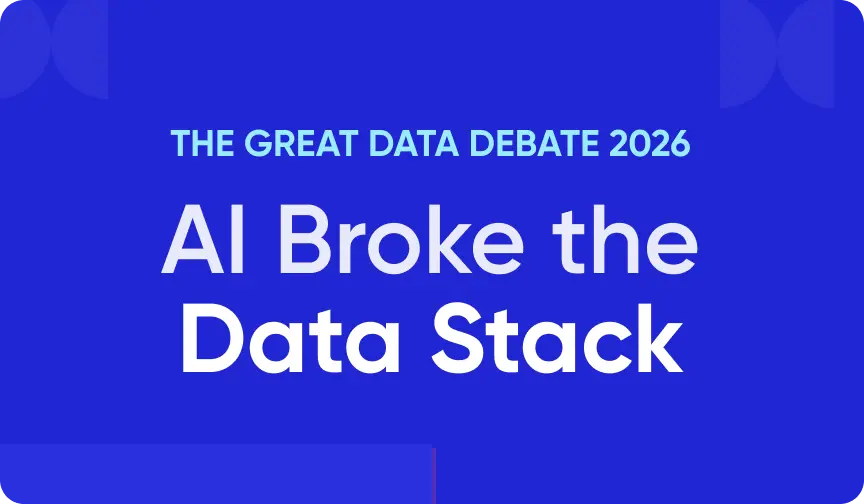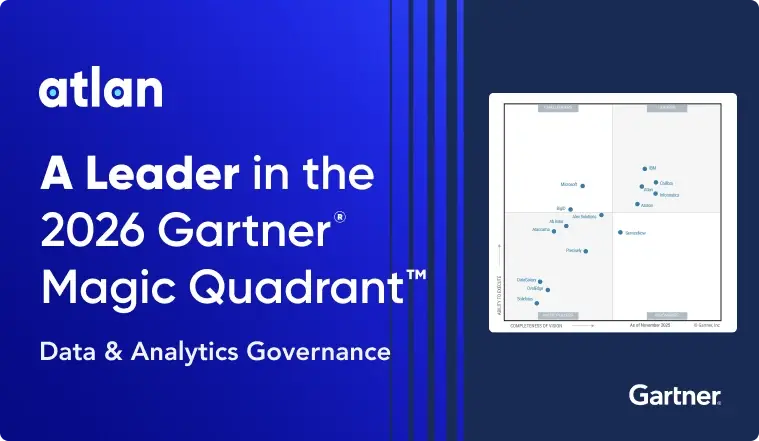Snowflake Cost Optimization: Typical Expenses & Strategies to Handle Them Effectively
Share this article
Setting up a data warehouse or a data lake has become easier with SaaS and purpose-built PaaS platforms. While a platform like Snowflake’s AI Data Cloud offers scale and simplicity, optimizing how you use it is key to avoiding runaway costs.
Scaling AI on Snowflake? Here’s the playbook - Watch Now
Snowflake cost optimization involves understanding where costs originate—compute, storage, data transfer—and making intentional choices to manage them.
This article will explore:
- Typical Snowflake costs
- What causes your Snowflake costs to spiral
- How to address cost optimization in Snowflake
- Snowflake’s native tooling for cost optimization
- How to use an external tool to manage costs
Table of contents
Permalink to “Table of contents”- How does Snowflake cost optimization work?
- What are Snowflake’s native features for cost optimization?
- What are the typical causes for high Snowflake costs?
- How can Atlan help with Snowflake cost optimization?
- Snowflake cost optimization: Summary
- Snowflake cost optimization: Frequently asked questions
- Snowflake cost optimization: Related reads
How does Snowflake cost optimization work?
Permalink to “How does Snowflake cost optimization work?”A small company on Reddit expressed frustration: “… how can Snowflake be comparable to our main AWS bill?” This is not uncommon.
To fix the cost-related issues with Snowflake, follow their recommended best practices and take a metadata-driven approach. You can use Snowflake’s metadata and tooling to identify common data modeling, engineering, movement, and management mistakes, which can add up to your Snowflake costs.
Alternatively, you can use external tools that connect with Snowflake and leverage the wealth of metadata stored in the ACCOUNT_USAGE schema.
Before exploring either solution, let’s investigate the root cause, understand Snowflake costs, and the typical reasons that cause it to grow exponentially.
Understanding Snowflake costs
Permalink to “Understanding Snowflake costs”Understanding Snowflake’s architecture and core services is extremely important when estimating its cost. Based on Snowflake’s architecture, costs fall into three categories: database storage, query processing, and cloud services. This results in Snowflake’s cost being split into the following categories:
- Compute: Virtual Warehouses, Serverless Compute, and Cloud Services Compute
- Storage: Snowflake-native storage used for Time Travel, Fail-safe, Table Clones, among other things
- Data transfer: Ingress and egress cost, especially when data movement is cross-region.
What are Snowflake’s native features for cost optimization?
Permalink to “What are Snowflake’s native features for cost optimization?”Snowflake offers features that allow you to understand how and why you are incurring the cost you are incurring. That’s where Snowflake’s Cost Management Framework comes into the picture. It helps you understand, explore, attribute, control, and optimize costs.
You can explore the costs by accessing the ORGANIZATION_USAGE and ACCOUNT_USAGE schemas to explore overall costs or feature-wise costs. Snowflake provides various out-of-the-box queries on top of these schemas that you can use for this purpose.
Once you have visibility into the costs, you can break them down and attribute them for accounting, organizational chargebacks, and optimization purposes using object tags and query tags.
You can also control your Snowflake costs using budgets and resource monitors, but the most important aspects of cost optimization come with the following three features:
- Cost insights provide general recommendations on common cost overshooting scenarios, such as having rarely used data assets like materialized views and tables with automatic clustering and large tables from which data is frequently written but rarely read.
- Cloud services optimizations help you identify common patterns that result in unnecessarily high costs and provide recommendations on how to fix those issues. Examples include queries being blocked because of transaction locks, granular and almost-OLTP-like inserts into tables, extremely complex SQL queries, etc.
- Cost anomalies are a brand-new feature released on May 16, 2025. They help you identify usage and consumption outliers based on past patterns using an algorithm. Cost anomalies can be used at the account and organization levels.
Snowflake keeps releasing newer features that help you understand and optimize costs across various components. One of the other features recently released was the Snowflake Egress Cost Optimizer, which helps in cross-cloud data sharing and auto-fulfillment. Understanding these various cost optimization controls within Snowflake is crucial for figuring out where the costs are coming from and how to optimize them.
Let’s now look at the typical causes of high costs in Snowflake.
What are the typical causes for high Snowflake costs?
Permalink to “What are the typical causes for high Snowflake costs?”High Snowflake costs usually result from failing to follow Snowflake’s cost optimization guidelines and sloppy use of resources. The most common causes that inflate your Snowflake costs are:
- Overprovisioning virtual warehouses
- Ignoring architecture best practices and guidelines
- Having database objects that are rarely used and unused
- Using unnecessary serverless compute features and services
- Transferring data unnecessarily across regions and cloud platforms
Let’s explore each issue further.
1. Overprovisioning virtual warehouses
Permalink to “1. Overprovisioning virtual warehouses”To understand your Snowflake compute needs, you should know your data volume, access patterns, workload types, data currency, and modeling requirements. This is central to knowing how much computing power you need to run queries without delays or interruptions.
Since you can scale your Snowflake warehouses up and down quickly, following their recommendations for initial warehouse sizes, and warehouse suspension and resumption can help reduce overprovisioning. These guidelines will also help you decide whether to use or avoid multi-cluster warehouses.
2. Ignoring architecture best practices and guidelines
Permalink to “2. Ignoring architecture best practices and guidelines”Snowflake will allow you to query your data at scale regardless of whether you follow an established data modeling pattern like Data Vault, dimensional modeling, or 3NF. The only problem that could arise is the cost.
Snowflake minimizes the impact of poorly modeled data by optimizing data storage and consumption with its proprietary micropartitioning and data clustering scheme. However, you must still follow guidelines for table design, dynamic tables, Iceberg tables, and clustering keys.
3. Having database objects that are rarely used and unused
Permalink to “3. Having database objects that are rarely used and unused”Unused database objects can silently increase costs. You must have an ownership and cost attribution tagging policy for objects to monitor these assets.
Snowflake provides granular metadata on object usage in the access_history table in the ACCOUNT_USAGE schema. It gives you a list of objects accessed by a given query. Analyzing this data can help you identify rarely used and unused database objects.
Typically, rarely used or unused database objects are seen in the form of tables, materialized views, short-lived permanent tables, temporary tables, and transient tables. Sometimes, you have whole schemas that are lying unused.
Removing these objects directly impacts the cost—it reduces the storage cost and the associated serverless compute cost for their maintenance and upkeep. It also has an indirect impact on the cost—cleaning up your Snowflake environment allows analysts and business users to consume data with less confusion and errors.
4. Using unnecessary serverless compute features and services
Permalink to “4. Using unnecessary serverless compute features and services”As mentioned earlier, Snowflake’s serverless computing is great but incurs additional costs. Understanding these features is important to optimizing Snowflake costs.
For instance, choosing the right table type for your use case is essential. If you create a permanent table for a one-time analysis job and then forget to delete it, it will automatically incur costs for fail-safe. Instead, for one-time analysis scenarios, consider using transient tables.
5. Transferring data unnecessarily across regions and cloud platforms
Permalink to “5. Transferring data unnecessarily across regions and cloud platforms”Data transfer, especially across regions or cloud providers, can be quite expensive. For large enterprises, this is one of the areas commonly overlooked, as the data transfer costs are not always completely obvious.
Snowflake has addressed this by allowing you to go multi-region and multi-cloud with zero additional egress cost with Egress Cost Optimizer (ECO). However, this is only meant to be used with auto-fulfillment and not for manual data replication.
There can be several other causes for high costs in Snowflake. We’ve just looked at the top five and explored some of the native features of Snowflake to understand and optimize these costs.
Although these are great features, you must create custom roles and permission models for your analysts and data engineers to fully utilize them. The elevated access and the additional overhead of running all the queries accumulate over time — and are counterintuitive to having a self-service-enabled data platform. That’s where a data catalog like Atlan can help.
How can Atlan help with Snowflake cost optimization?
Permalink to “How can Atlan help with Snowflake cost optimization?”Atlan offers a solution for cost optimization at three levels, utilizing an end-to-end lineage graph built from Snowflake’s cost and usage metadata:
- Level 1: An end-to-end lineage graph identifies unused and duplicate data assets, which you can certify as deprecated, ready to be deleted or archived from your Snowflake account.
- Level 2: Asset popularity metrics help identify low-usage assets that can be certified as deprecated. Atlan uses four metrics to identify candidates for deprecation :
- Number of queries using an asset
- Number of users using an asset
datetimeof the last query run using the assetdatetimeof the last update that was made to an asset
- Level 3: Atlan targets the most popular, most queried, and most expensive assets using asset popularity metrics, such as assets with the most number of queries, users, and Snowflake credits.
Snowflake cost optimization: Summary
Permalink to “Snowflake cost optimization: Summary”This article covered the numerous aspects of Snowflake costs, typical causes of high expenses, and methodologies for cost optimization. We also looked at using Snowflake’s native tools and external tools like Atlan to optimize Snowflake costs.
Atlan’s multi-layered cost optimization strategy uses end-to-end lineage and popularity metrics to identify and deprecate less frequently used and unused data assets, resulting in considerable cost savings.
Want to know more? Chat with our data strategy experts who’ve guided data teams at Nasdaq, Autodesk, and HelloFresh in their modern data governance journey.
Snowflake cost optimization: Frequently asked questions
Permalink to “Snowflake cost optimization: Frequently asked questions”1. What do Snowflake costs depend on?
Permalink to “1. What do Snowflake costs depend on?”Snowflake costs are primarily driven by three categories: compute (virtual warehouses and serverless features), storage (including Time Travel and Fail-safe), and data transfer (especially across regions or cloud providers). The configuration of workloads, frequency of use, and data volume directly influence these costs.
2. What drives Snowflake costs the most?
Permalink to “2. What drives Snowflake costs the most?”Overprovisioned virtual warehouses, unused or rarely accessed data assets, unnecessary serverless operations, and inefficient data movement across regions or clouds are the most common causes of spiraling Snowflake expenses.
3. How can I reduce costs in Snowflake?
Permalink to “3. How can I reduce costs in Snowflake?”Start by auditing usage via ACCOUNT_USAGE and ORGANIZATION_USAGE schemas. Remove unused objects, optimize warehouse sizes, limit serverless workloads, tag assets for chargeback visibility, and leverage features like Cost Insights and Resource Monitors to catch inefficiencies early.
4. What are Snowflake’s native cost optimization tools?
Permalink to “4. What are Snowflake’s native cost optimization tools?”Snowflake provides native cost visibility and control through Cost Insights, Cost Anomalies, Resource Monitors, budgets, and metadata schemas like ACCOUNT_USAGE. These tools help detect usage spikes, attribute costs, and control spend with proactive alerts.
5. Why is metadata critical for Snowflake cost control?
Permalink to “5. Why is metadata critical for Snowflake cost control?”Metadata enables you to understand data usage, trace dependencies, and identify ownership. This visibility supports smarter decisions around deprecation, workload sizing, and cross-functional cost accountability across engineering, analytics, and governance teams.
6. How does Atlan help optimize Snowflake costs?
Permalink to “6. How does Atlan help optimize Snowflake costs?”Atlan connects to Snowflake’s metadata and usage layers, automatically mapping lineage and calculating asset popularity. It flags redundant or stale data, highlights high-cost tables, and enables governance workflows to clean up or reassign resources efficiently.
7. What are the benefits of using a metadata control plane for Snowflake cost optimization?
Permalink to “7. What are the benefits of using a metadata control plane for Snowflake cost optimization?”A metadata control plane like Atlan unifies cost signals across your stack, integrates with Snowflake’s native tooling, and adds context through lineage, popularity, and governance policies. This helps teams reduce costs faster while improving trust and data usability.
Snowflake cost optimization: Related reads
Permalink to “Snowflake cost optimization: Related reads”- Snowflake Summit 2025: How to Make the Most of This Year’s Event
- Snowflake Cortex: Everything We Know So Far and Answers to FAQs
- Snowflake Copilot: Here’s Everything We Know So Far About This AI-Powered Assistant
- Polaris Catalog from Snowflake: Everything We Know So Far
- Snowflake Horizon for Data Governance: Here’s Everything We Know So Far
- Snowflake Data Cloud Summit 2024: Get Ready and Fit for AI
- How to Set Up a Data Catalog for Snowflake: A Step-by-Step Guide
- How to Set Up Snowflake Data Lineage: Step-by-Step Guide
- How to Set Up Data Governance for Snowflake: A Step-by-Step Guide
- Snowflake + AWS: A Practical Guide for Using Storage and Compute Services
- Snowflake X Azure: Practical Guide For Deployment
- Snowflake X GCP: Practical Guide For Deployment
- Snowflake + Fivetran: Data movement for the modern data platform
- Snowflake + dbt: Supercharge your transformation workloads
- Snowflake Metadata Management: Importance, Challenges, and Identifying The Right Platform
- Snowflake Data Governance: Native Features, Atlan Integration, and Best Practices
- Snowflake Data Dictionary: Documentation for Your Database
- Snowflake Data Access Control Made Easy and Scalable
- Glossary for Snowflake: Shared Understanding Across Teams
- Snowflake Data Catalog: Importance, Benefits, Native Capabilities & Evaluation Guide
- Snowflake Data Mesh: Step-by-Step Setup Guide
- Managing Metadata in Snowflake: A Comprehensive Guide
- How to Query Information Schema on Snowflake? Examples, Best Practices, and Tools
- Snowflake Summit 2023: Why Attend and What to Expect
- Snowflake Summit Sessions: 10 Must-Attend Sessions to Up Your Data Strategy
Share this article





















